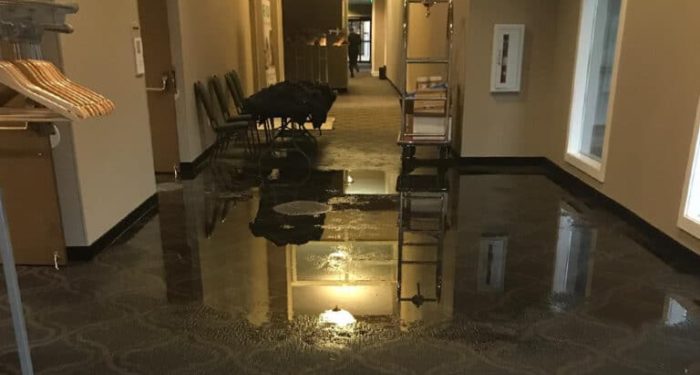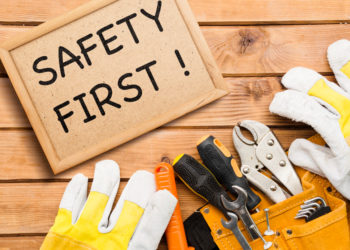What Is the Process of Water Damage Restoration?
Water damage restoration is a complex process that requires expertise and special equipment. It is critical to take immediate action to minimize the potential harm to your belongings and property. Let’s dive into the details.
Initially, water extraction is necessary to remove standing water. This is then followed by the drying process, which is typically achieved using industrial-grade dehumidifiers and air movers. Specialized equipment may be used to detect hidden water behind walls and under floors. Prompt removal and drying can prevent mold growth and further damage.
The next step of the aftermath involves cleaning and sanitizing. This includes the affected area as well as any belongings that can be saved. It’s crucial to decontaminate the area to prevent any potential health risks. Proactive steps are taken to prevent the recurrence of the problem.
The final lapse of the restoration process is repair and restoration. This could range from replacing a few panels of drywall to rebuilding entire rooms from scratch. Remember, a professional restoration service like ours aims to restore your property to the original or even better condition.
Identifying Water Damage
The primary step in the restoration process after any water related accident within your home or commercial premises is identifying water damage. This is a critical phase that helps you recognize problematic areas and the extent of impact before undertaking any remedial measures.
Look for Color Changes
Water damage often impacts the color and texture of surfaces it infiltrates. It can manifest as discolored patches, peeling paint, or wet spots on your walls and ceilings.
Examine Structural Integrity
A sign to spot severe water damage involves checking for structural weaknesses. This includes spongy floors, crumbling drywall, warped wood, or ceilings appearing bloated with water.
Detect Unusual Odors
Water logged into enclosed spaces often creates a musty odor. If you find certain areas in your basement or other parts of the house emanating such smells, it’s likely due to unattended water damage.
Note Increased Humidity
Your home’s humidity levels could also indicate water damage. Unusual condensation on windows or a clammy feel in rooms may point toward hidden water leaks or moisture build-up.
Statistically speaking, up to 98% of basements in the U.S. will experience some type of water damage during their lifespan. Therefore, regular checks and early identification strategies for water damage are essential to maintain healthy residential surroundings.Initial Damage Inspection
When you face water damage, your first step should be a thorough damage inspection. This involves checking all areas affected by water incursion. It’s necessary to identify the extent and type of damage so a proper restoration plan can be created.
During inspection, professionals look for visible signs of water damage like discoloration, warping, or peeling paint. Also, specialized equipment might be used for assessing any hidden damage. It’s important to know that rapid response is crucial in these situations.
- Be Proactive: About 75% of water heaters fail before they are 12 years old, potentially causing water damage. Regular maintenance and timely replacement of such appliances can save you from significant trouble.
- Identify the Water source: The origin of the water determines the severity of the damage and the restoration method to be implemented.
- Safety Measures: Turn off electrical appliances in damp areas until they dry out completely to avoid any risk.
The inspection time depends on the size and complexity of the project. You need patience because missing out on any details can result in secondary damages later on.
Last but not least, always hire certified professionals for your water damage inspection. They should provide a report detailing all findings and recommendations for restorative measures.
Water Extraction Process
The first step in water damage restoration is the extraction process. Here, all standing water is removed from your home using specialized equipment. This reduces the overall damage and accelerates drying.
Industry professionals categorize water damage into three levels of severity. Class 1 comprises only a small area and minimal absorption in materials. Class 2 affects an entire room, soaking into carpeting and walls. Class 3 is the most severe, with water saturating most areas and potentially coming from overhead.
| Class | Description |
| 1 | Small area, minimal absorption |
| 2 | Affects entire room, soaks carpeting and walls |
| 3 | Saturates most areas, potentially from overhead |
| Table 1: Water Damage Classes and Descriptions |
Note that water damage insurance claims account for approximately 50% of all home insurance claims. Therefore, knowing how to deal with such situations is crucial.
This extraction process helps prevent further damage caused by the prolonged presence of moisture. So, it’s essential to act quickly when you notice water damage.
Drying and Dehumidification
Once the water extraction is finished, your property’s drying and dehumidification process begins. This step is crucial as excess moisture can lead to mold growth, presenting potential health hazards.
Professional restoration companies use industrial-grade equipment such as air movers and dehumidifiers to expedite the drying process.
- Use of Air Movers: These create airflow across walls, carpets, pads, and furniture, evaporating the remaining moisture.
- Utilization of Dehumidifiers: These extract water from the air and help protect your property and its belongings from further water damage.
This process varies in time depending on factors like location, duration of exposure to water, and the type of water involved. On average it takes 3-5 days to thoroughly dry a residential property.
You dealing with the aftermath might be overwhelming, but remember professional help ensures a thorough and swift return to your normal activities without further problems related to untreated damages.
Cleaning and Sanitizing
Once a water damage incident happens, it’s important to set immediate restoration in motion to minimize any further damage. This process begins with meticulous cleaning and sanitation.
Immediate Cleanup Procedures
After assessing the extent of the water damage, professionals begin by removing standing water using specialized equipment. Then, they start the cleanup process which includes thoroughly washing affected areas with special cleaning products and disinfectants.
Sanitation Importance
The sanitization process is a crucial step. It removes potential health hazards such as harmful bacteria and molds that usually stems from water damage. Being diligent about sanitation can make your home safer post-water damage.
Drying and Dehumidifying
After cleaning and sanitizing the area, drying and dehumidification come next for all affected surfaces. This procedure protects against mold growth, which can easily settle in wet or damp conditions.
Relevant Fact
An interesting fact to remember is that water damage frequently occurs in homes. According to statistics, water damage, often accompanied by freezing conditions, ranks as the second most common reason for home insurance claims—the top being wind and hail damage.
Structural Repairs and Restoration
When faced with water damage, your property’s structural integrity is often affected. It’s essential to get started quickly with the restoration process to prevent further damages. An expert team will assess the extent of damage and provide a well-defined roadmap for recovery.
An integral part of the process is making necessary repairs. Structures, such as walls, floors, and ceilings can severely be weakened by water damage. As the property owner, it’s vital that you proactively engage in this step to ensure your safety and avoid future issues.
- Inspection and Damage Assessment: This involves a comprehensive review of your property to identify and record all sites affected by water damage.
- Drying and Dehumidification Process: High-grade drying equipment is used along with dehumidifiers to help accelerate the drying process and inhibit the growth of mold.
- Cleaning and Sanitising: This step ensures all areas are cleaned comprehensively and any unwanted odors from stagnant water are eliminated.
- Restoration: The final step in bringing your property back to its pre-water damage condition includes repairs, replacement of damaged items, and repainting where necessary.
It’s worth noting here that 93% of all water damage can be prevented with proper maintenance. Early detection systems like water leak detectors can greatly reduce the risk of extensive damage. As part of maintenance efforts, home and property owners should take proactive steps in developing a contingency plan should water damage occur.
This critical process seeks not only to repair explicitly visible damages but also addresses underlying issues such as mold growth or structural weakness. Hence, restoring your property to its former glory demands more than just superficial repair work.
Evaluating Restoration Success
After a successful water damage restoration, it’s essential to evaluate the quality of the work performed. It’s not enough to just dry the area and patch things up. A successful water damage restoration should address potential hazards and deliver long-lasting solutions.
You need to assess the job thoroughly after its completion. Recommended steps for evaluating water damage restoration are:
- Inspect visually: Look for apparent signs of remaining water damage. Check walls, ceiling, and floors for discoloration or warping.
- Smell test: The presence of a musty odor can indicate unresolved mold growth.
- Touch check: Feel surfaces for dampness. Persistent moisture can signify improper drying.
Remember, long-term issues may not present immediately following restoration. Stay vigilant and periodically check the formerly affected areas.
If you notice any lingering signs of water damage, contact your restoration professional immediately. Prompt action can mitigate further complications and additional expenses. A thorough evaluation ensures that your property is completely restored and safe to inhabit.
Restoring from Water Damage
Water damage restoration involves identifying the water source, damage evaluation, water extraction, drying and dehumidification, cleaning, sanitizing, and restoration. Key details of this process can be comprehended fully by visiting this site.











































































